By: Travis Allen
@wizardbumpin
If you don’t have a Twitter account yet, I can’t recommend highly enough that you sign up. This weekend, while answering Tumblr questions, this beauty popped up:
Within minutes the Magic twitterverse was falling over itself trying to figure out what to make of this. Were they repealing the Reserve List? Leaving it standing, but removing specific cards? Could this have to do with the new CEO? I’m sure I’m not the only one who almost immediately began thinking about the 40 Revised duals in my binder. Then, not long after, this popped up:
Whether it was Tumblr’s mistake (possible) or user error (likely), the whole tempest in a teapot was over not long after it began. It was a fun two hours though!
Aaaaanyways, over at Grand Prix Secaucus this weekend, we were treated to Sam Black making everyone get real excited because he was resolving The Great Aurora late in day two while making a run at (and missing) the top eight. What more could fans of Magic possibly want to see on one of the game’s largest stages? Competitive decks casting Seasons Past and The Great Aurora is basically all of our hopes and dreams realized; it’s the Magic we all loved as beginners and were then told isn’t good enough for constructed. Nine mana may as well be single payer healthcare, sorry buddy. Stick to one drops, incremental gains, and Hillary Rodham Clinton. Really, The Great Aurora is Bernie Sanders’s campaign as a Magic Card.
While the price hasn’t moved (much) on TGA yet, it may by the time this goes live. And even if it doesn’t, that’s mostly because Black was only running one copy. Yet Seasons Past was in the $6 to $10 range shortly after Pro Tour Shadows Over Innistrad, and Finkel was running just one additional copy, for a total of two. I’m sure that the fact that it was the Pro Tour and it was Jon Finkel helped there quite a bit.
Several weeks ago, when Shadows Over Innistrad was still being cracked at release events, a UR control list showed up at the first SCG Open of the year that ran Pyromancer’s Goggles to great effect. The price exploded, and after a strong follow-up performance a week later, the price was surprisingly resilient. Pyromancer’s Goggles, a five mana artifact that taps for a single red mana the turn it comes into play. That’s a far cry from the safe choice of Town Gossipmonger.
That’s three (I guess maybe two and a half) large, splashy, “that’s an EDH card” cards that have made big waves in Standard all of the sudden, with price tags to match. Seeing cards like this become relevant in Standard is uncommon, and it feels like we’ve seen more of it in the last six months than average. Still, it seems as if there’s a strong incentive to look towards these huge, EDH-caliber cards. What if we look backwards?
I flipped through all the cards that were at least six mana and jumped out at me as specifically EDH cards over the last few years. I also included artifacts down to four mana, since there were specifically a few cheap ones I wanted to think about: Alhammatret’s Archive and The Chain Veil, for instance.
I also only included cards that had price points I considered relevant. Resolute Archangel is an awfully EDH card, but with a current price of $.25 and no upward movement, it’s not really worth considering right now. Same with Hedonist’s Trove. Hornet Queen, on the other hand, while having 0% gains, is already at least $1, saw a lot of movement at one point in time, and is subjectively a more relevant card.
This list is entirely subjective of course; Worldfire screams EDH to me even though it’s banned, and I probably skipped over something you would have listed. I’m also not sure how popular a card like Elderscale Wurm is, though it seems quite reasonable in the format. In any case, let’s call it a non-comprehensive and imperfect list.
This is all the cards, sorted by the percent gain they’ve seen since they were released. Right at the top is Pyromancer’s Goggles, one of the many gifts Magic Origins has given us. At the bottom is Ugin’s Nexus, a card whose price has basically not changed. Some of the prices here have more going on than is obvious at first glance. For instance, Primeval Bounty was played in Standard, and had some price movement back then. Similarly, Hornet Queen was more expensive than it is today thanks to Standard.
I’m going to cut out all the cards whose prices are currently predicated on competitive demand. This is cards like Pyromancer’s Goggles and Seasons Past. Those are very compelling reasons to consider picking up cheap EDH cards, but that’s a bonus, not a reliable feature, and I want to think about these cards mostly as long-term casual staples instead. I’m leaving a card like Hornet Queen though, because even though it was popular in Standard at one time, the price today is entirely due to EDH. You’ll also see The Great Aurora on here, because its price isn’t based on competitive play — yet.
Would you have guessed Boundless Realms is the most profitable EDH card printed in the last 4 years or so? I wouldn’t have! At least, the most profitable high-cmc card. 550% growth is no joke, and had you bought a few hundred of these at their low point, you’d be a richer man for it.
In order to unpack this list, we’ll look at it through a few filters. First, I want to look at card types. How do artifacts fare?
Wow, artifacts look excellent. 7 of the top 11 slots are artifacts. Is part of that perhaps that I included artifacts with a lower CMC than the other spells? I don’t think so. Only one artifact with strong gains fell below my six mana cutoff; Gilded Lotus. The other three that fall below that threshold are also the three with the smallest gains in the top half.
You’ll also notice that the older they are, the better they look. All the best performing artifacts are oldest, with the four smallest gains coming on on the four youngest copies.
Clearly there’s a strong correlation here. Artifacts as a card type do great. Is this because they can be cast in any deck? Possibly. Probably. Aside from The Chain Veil and maybe Darksteel Forge, those are all cards I would consider fairly universal, as in most EDH decks would be happy to play any or all of them.
How about Sorceries?
These are much more distributed than artifacts, but given how dense artifacts are at the top, they couldn’t not be. We see that the best performing card in our list is in fact a sorcery, but also so is one of the cards with 0% gain. Overall, they’re evenly spread through the list.
There’s no noticeable correlation with converted mana costs amongst sorceries as far as I can tell, though I do see that age is fairly important. There’s a clear trend towards towards younger cards as you move from top to bottom, especially if you ignore Worldfire, which again, is currently banned in EDH. That’s certainly worth noting — age seems to play a big part in the value of sorceries, and probably most cards. This shouldn’t come as a surprise to anybody of course. The older a card is, the fewer copies there are, and the higher prices are pushed.
Speaking of age, let’s look at that metric.
With age in months color coded, there’s a distinct trend. Older cards take up a lot more real estate at the top of the chart than the bottom. If you kick out Woldfire and Elderscale Wurm, a creature whose prevalence in EDH I’m beginning to question, it becomes even more pronounced. Now notice that Primeval Bounty, one of the oldest, least-impressive cards started at $3.50, making large gains tougher than if it had started at $1. Were it ever that cheap, it would be the second largest gain on our chart!
We saw trends in both artifacts and sorceries that age is an indicator of gains, and this graph serves to lend strength to that notion.
Huh, creatures have not done too well. Even Diluvian Primoridal, a creature of unquestionable utility in EDH and over three years old, still hasn’t broken a $1. This isn’t a foil/nonfoil thing either; foils are like $2. I guess Colossus of Akros did fairly well, though that is an awfully splashy creature in a way that few others are. (Cool tidbit: @deejfordicus is the model for Colossus.) Hornet Queen, another extremely powerful creature in the format, is also quite low. It’s also not been too long since a reprint either. Will Hornet Queen end up on the top end of this chart in a year or two? It doesn’t seem unreasonable, though the sub par performance of creatures in general isn’t inspiring. Endbringer is also a creature I could see show up in nearly every EDH deck down the road, but will it be enough to buoy it above $2?
Finally, does converted mana cost matter?
Nope.
One thing I’d really like to look at, but don’t know how, is some sort of power level metric. I think about a card like Rise of the Dark Realms, which almost always wins its caster the game, compared to a spell like Ghastly Conscription, which seems like a much worse version of the same effect. I have no way to measure this though. At first I thought I could use EDHREC’s prevalence feature, which tells me how many decks out of their entire database a card shows up in, but it’s not accurate at all because it doesn’t account for cost. Woodland Cemetery shows up in three times more decks than Bayou, and the latter is unquestionably better than the former. Similarly, The Tabernacle at Pendrell Vale only shows up in a little over 100 decks — do you think that’s because it’s not a strong card, or because people can’t afford the $1,000 for an EN copy? It’s really unfortunate we don’t have a reliable way to rate cards like this, because I think it would be quite telling. This is where the MTG in “mtg finance” comes in I guess. You need to use your knowledge as a player to differentiate which are truly powerful spells.
Our rough-hewn analysis has revealed a few trends. Artifacts definitely seem to perform best, with sorceries taking a distant second. Creatures historically haven’t stacked up well — at least, not the high mana cost ones. (Solemn Simulacrum would have been at the top of the list had I included him, but he’s a touch too old. Lower CMC cards would be a different list though.) Age is certainly a factor in price, though being old doesn’t mean a card has to be expensive.
All of those charts cut the competitive cards too, remember. Pyromancer’s Goggles and Seasons Past were near the top of the chart, and Omniscience would have been first had I used it’s historical lows and highs; $4 and $40 respectively. Had you bought in right away at their lows you would have made bank, yet that begs the question, had they not broken out in constructed, would they still have been windfalls? That’s a future we’ll never know, though I’m willing to bet at least Omniscience and perhaps Goggles would have done well.
There’s another thing I want to show you too. Here’s the price graph for Rise of the Dark Realms:
That’s a slow, steady growth over time. No cliffs and walls here. Just consistent demand coupled with attrition. Most of the cards on the list look something like that. If it isn’t quite that smooth, it’s a series of steppes instead, which is basically the same thing. Given what we’ve seen about how age works — older cards are more likely to be valuable — and the price graph above, there’s a reasonably obvious answer about when to buy. We’re definitely incentivized to pick up our copies nearly as soon as the card is printed, or at least during the card’s lull a few weeks after release. Grabbing a card that’s already two to three years old may be too late, or at least, will be less profitable. Either it’s a card that’s rising, in which case after two years you’ve already waited too long, or the price is still flat after two years, in which case it may be a dud. In other words, buying any of the cards on the list above that aren’t at least as new as Battle for Zendikar may be a bad idea. I could see Clone Legion; in fact, I kind of like that one, but it’s still fairly fresh all things considered. Ugin’s Nexus though? Ghastly Conscription? No thanks.
Overall, it looks like anything we pick up we’ll most likely be in for the long haul, unless we get stupidly lucky such as with Pyromancer’s Goggles. We should definitely look at huge, powerful artifacts, or ones that do great things for your mana, such as Gilded Lotus or Chromatic Lantern. (Latern didn’t show up on our list because it was too cheap, but have you seen the price of that card lately?) Sorceries are good too, but you want ones that really do something. Boundless Realms ramps you for like six or seven. Rise of the Dark Realms often kills your opponents on resolution. Don’t worry too much about mana cost in either direction; so long as it has a profound effect, it’s good. And creatures in general are unexciting, though I admit to being drawn to Endbringer and Hornet Queen.
As for me? I’ll probably stash some of The Great Aurora, some Clone Legion, Endbringer (because I’m dumb), and possibly Alhammarret’s Archive if I can find them for a good price, because that card is stupid. I’ll also begin watching each new set closely for the gigantic EDH staples and begin buying in much sooner than I have in the past.
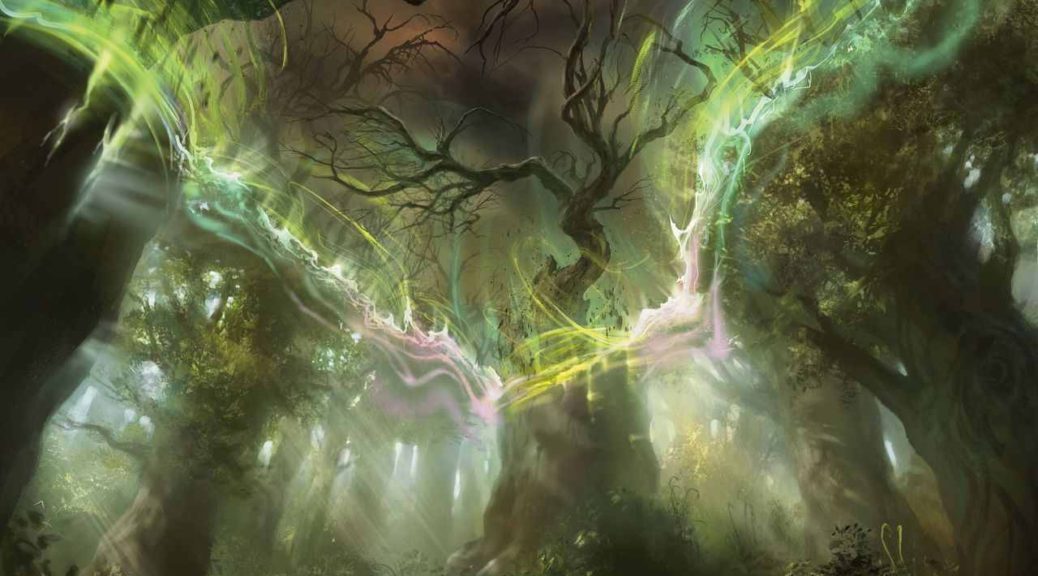
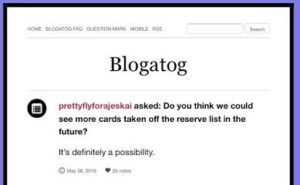
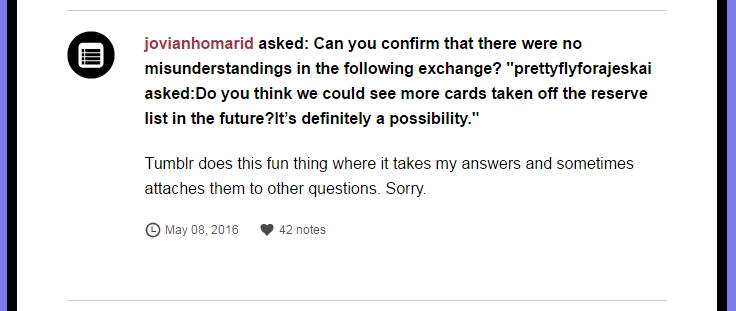



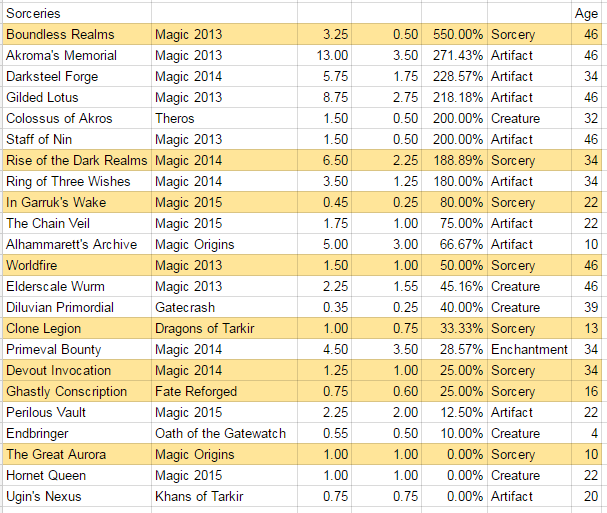

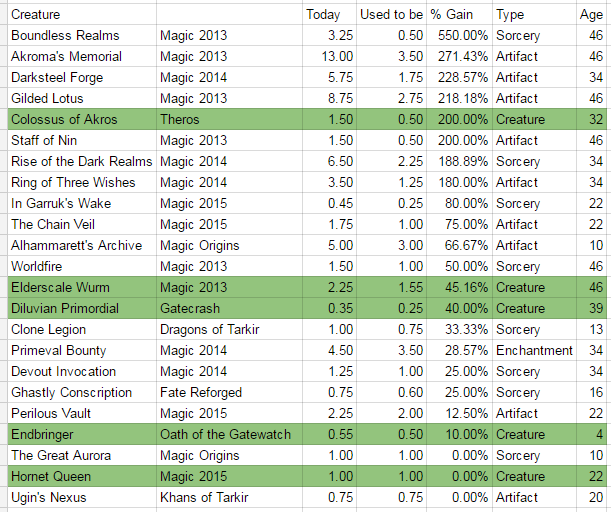
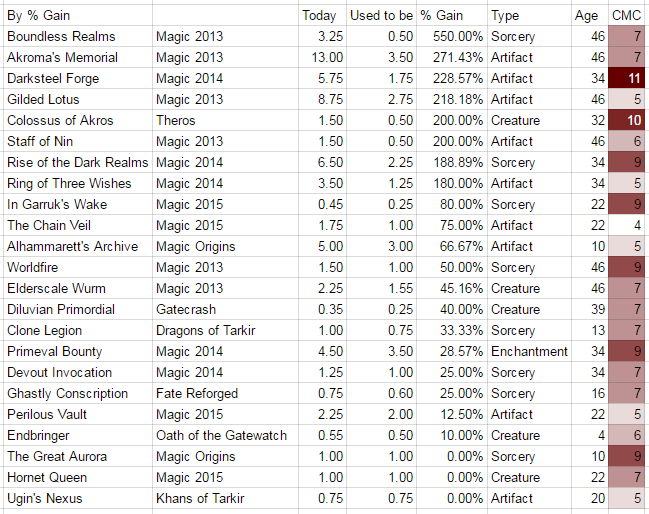

“Nine mana may as well be single payer healthcare”
*REGGAE AIRHORNS*
*FIRE EMOJI*
Winner, best joke in an MTG finance article, 2016.
Another correlation is 90% of that list are from core sets which are historically less opened so lower supply.
I wonder how viable it would be to use this data to predict future spikes of slightly older cards.
That’s basically the point. Find huge, game-ending EDH cards, buy them at 0-12 months, then cash in two to four years later.
What an awesome read. I think your insight is spot on, and I agree that seeing these high cmc spells being cast in competitive standard is sweet. This got me thinking about a few shadows cards that may or may not fall in line with this article.. What do you guys think about Behold the Beyond or Descend upon the Sinful as EDH cards? Are these the type of cards that could follow a similar growth pattern? Or are they not quite powerful enough? I think you can find Behold for like 50 cents right now. Anyways, great stuff, and of course you guys are killing it with the fast finance podcast. Keep it rolling!
Behold the Beyond is just a significantly worse Diabolic Revelation, so I’d go that route if anything.
Awesome article. Your breakdown of more-recent artifacts is perfect. Ugin’s Nexus, Alhammarett’s Archive, Akroma’s Memorial, Darksteel Forge and Colossus of Akros are amazing cards (though expensive, as you mentioned). Adding some older cards like Platinum Angel(s), Darksteel Juggernaut(s) and/or Darksteel/Blightsteel Colossus, Oblivion Stone, Turn to Dust(s) makes for a fun and powerful colorless deck with a room to grow value-wise (maybe not each of those cards will increase – but the combination of cards as a whole).
Have a look at Quicksilver Amulet as well if you are really into the artifact specs. You can get it out early and have 8cmc+ creatures hitting the board by turn 4 or 5. Seems like it could be good in an Eldrazi Build (any deck with enough huge fatties really?). I use it in a lot of green or green/white decks with huge fatties. Some of my favorite targets for it are Hornet Queen, Regal Force, Vorinclex, Craterhoof Behemoth Avacyn, Angel of Hope, etc. And thats just in green/white… I’m sure there are some black/red and or colorless decks that might want this as well.
As Magic gets older, we get more and more creatures with great effects attached to them. That means that older cards like Quicksilver Amulet just keep getting better and better. This card is like collected company or aether vial for EDH, it will age well over time. IF Quicksilver Amulet dodges reprints this year I think its a great spec. Even if it is reprinted, there is the original artwork version (Lion) that is still appealing.
How do you think recently spiked standard cards like Seasons Past, Dark Petition and Cryptolith Rite will fare after they rotate from standard? They were all on my pseudo “list” of cards that would be good in EDH or could be powerful in the right decks. Will these drop like rocks when they rotate or will we only see them drop a dollar or two?
If you had to guess… which of these cards might still have EDH demand 2 years from now? Which (if any) would you consider buying into again if we see a dip in price?
Sorry, I meant All is Dust in my previous post.